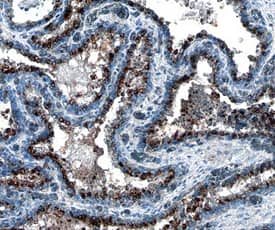Human BMPR-IA/ALK-3 Antibody
R&D Systems, part of Bio-Techne | Catalog # MAB24061

Key Product Details
Species Reactivity
Applications
Label
Antibody Source
Product Specifications
Immunogen
Gln24-Arg152
Accession # P36894
Specificity
Clonality
Host
Isotype
Scientific Data Images for Human BMPR-IA/ALK-3 Antibody
BMPR‑IA/ALK‑3 in Human Prostate.
BMPR-IA/ALK-3 was detected in immersion fixed paraffin-embedded sections of human prostate using Mouse Anti-Human BMPR-IA/ALK-3 Monoclonal Antibody (Catalog # MAB24061) at 25 µg/mL overnight at 4 °C. Tissue was stained using the Anti-Mouse HRP-DAB Cell & Tissue Staining Kit (brown; Catalog # CTS002) and counterstained with hematoxylin (blue). Specific staining was localized to cytoplasm in epithelial cells. View our protocol for Chromogenic IHC Staining of Paraffin-embedded Tissue Sections.Applications for Human BMPR-IA/ALK-3 Antibody
Immunohistochemistry
Sample: Immersion fixed paraffin-embedded sections of human prostate
Formulation, Preparation, and Storage
Purification
Reconstitution
Formulation
Shipping
Stability & Storage
- 12 months from date of receipt, -20 to -70 °C as supplied.
- 1 month, 2 to 8 °C under sterile conditions after reconstitution.
- 6 months, -20 to -70 °C under sterile conditions after reconstitution.
Background: BMPR-IA/ALK-3
Cellular responses to bone morphogenetic proteins (BMPs) have been shown to be mediated by the formation of hetero-oligomeric complexes of the type I and type II serine/threonine kinase receptors. BMP receptor 1A (BMPR-1A), also known as activin receptor-like kinase (ALK)-3, is one of seven known type I serine/threonine kinases that are required for the signal transduction of TGF-beta family cytokines. In contrast to the TGF-beta receptor system in which the type I receptor does not bind TGF-beta in the absence of the type II receptor, type I receptors involved in BMP signaling (including BMPR-IA, BMPR-IB/ALK-6, and ActR-I/ALK-2) can independently bind the various BMP family proteins in the absence of type II receptors. Recombinant soluble BMPR-IA binds BMP-4 with high-affinity in solution and is a potent BMP-4 antagonist in vitro. BMPR-IA is ubiquitously expressed during embryogenesis. In adult tissues, BMPR-IA mRNA is also widely distributed with the highest expression levels found in skeletal muscle. The extracellular domain of BMPR-IA shares little amino acid sequence identity with the other mammalian ALK type I receptor kinases, but the cysteine residues are conserved. Human and mouse BMPR-IA are highly conserved and share 98% sequence identity
References
- Kawabata, M. et al. (1998) Cytokine and Growth Factor Reviews 9:49.
- Ebendal, T. et al. (1998) J. Neuroscience Research 51:139.
Long Name
Alternate Names
Gene Symbol
UniProt
Additional BMPR-IA/ALK-3 Products
Product Documents for Human BMPR-IA/ALK-3 Antibody
Product Specific Notices for Human BMPR-IA/ALK-3 Antibody
For research use only
